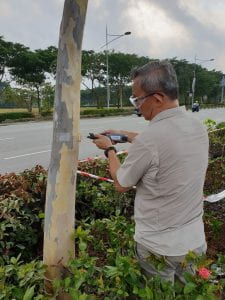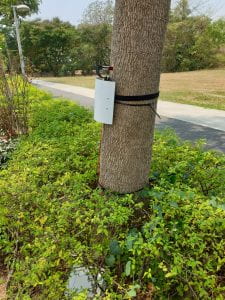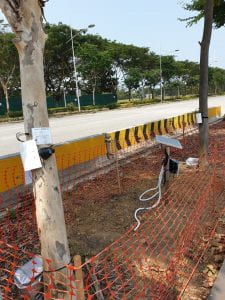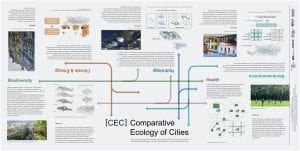Research Projects
(1) Comparative Ecology of Cities
The inevitability of increasing urbanization and the attendant problems it creates place an urgent demand on our ability to shape current and future urban development using a science-based approach to urban planning. The project is centred on the proposition that urban pattern-process-function relationships provide valuable knowledge to advance the science of urban planning, but this has thus far remained relatively unexplored and under – utilized in practice. The project builds upon emerging theoretical and empirical evidence that patterns of human settlement systems (urban patterns) shape social and ecological processes (urban processes), and such processes, in turn, dictate the key demands of urban living such as social relations, mobility, economic exchanges, bioenvironment, ecological conditions, etc. (urban functions). The project will investigate pattern-process-function relationships across a large number of cities to address research questions aligned to FCL Global’s (FCLG) aims of developing solutions to guide sustainable urbanization, for humans, the environment and biodiversity.
(2) Assessment of Eco-physiological Processes in Urban Vegetation
(i) Assessment of sap flow and transpiration of urban trees and evaporative cooling
The benefits provided by urban vegetation are fundamentally driven by physiological processes in plants, such as photosynthesis and transpiration, which are in turn, coupled to ecosystem processes, such as water, energy and nutrient flux, and cycling. Understanding physiological processes is thus a key step towards optimizing the contribution of plants to provide functional benefits. With other colleagues, one area of work by the lab has been to investigate the process of transpiration and evaporative cooling in trees under the influence of nativity and functional traits, and how this knowledge might be used to improve urban cooling by trees.





See these publications:
- Tan, P. Y., N. H. Wong, C. L. Tan, S. K. Jusuf, K. Schmiele and Z. Q. Chiam. (2020). Transpiration and cooling potential of tropical urban trees from different native habitats. Science of the Total Environment: 135764. https://doi.org/10.1016/j.scitotenv.2019.135764
- Tan, P. Y., Wong, N. H., Tan, C. L., Jusuf, S. K., Chang, M. F., Chiam, Z. Q. (2018). A method to partition the relative effects of evaporative cooling and shading on air temperature within vegetation canopy, Journal of Urban Ecology 4(1):juy012-juy012. https://doi.org/10.1093/jue/juy012
- H. Wong, C.L. Tan, P.Y. Tan, S.K. Jusuf, S. Tong and D.J.C. Hii. (2020), Cooling the urban environment: Effect of tree transpiration on outdoor air temperature, in: Douglas, I., Anderson, P. M. L., Goode, D., Houck, M. C., Maddox, D., Nagendra, H., & Tan, P. Y. (2020). The Routledge Handbook of Urban Ecology: Taylor & Francis, https://www.routledge.com/The-Routledge-Handbook-of-Urban-Ecology/Douglas-Anderson-Goode-Houck-Maddox-Nagendra-Tan/p/book/9781138581357
- He, Y., Lin, E.S., Tan, C.L., Yu, Z., Tan, P.Y., Wong, N.H. (2021). Quantitative evaluation of plant evapotranspiration effect for green roof in tropical area: A case study in Singapore. Energy and Buildings, 241, 110973. https://doi.org/10.1016/j.enbuild.2021.110973
- He, Y., Lin, E.S., Tan, C.L., Yu, Z., Tan, P.Y., Wong, N.H. (2021). Model development of Roof Thermal Transfer Value (RTTV) for green roof in tropical area: A case study in Singapore. Building and Environment, 203, 108101. https://doi.org/10.1016/j.buildenv.2021.108101
(ii) Assessment of photosynthetically active radiation in the built environment
While urban vegetation are expected to provide a suite of ecosystem services, the ability of plants to deliver such services is likely to be constrained by environmental conditions in the built environment–heat, drought, air pollution, shade, etc. We studied the effects of building shade in affecting plant photosynthesis for ornamental and urban agriculture. We also developed methods for determining distributional patterns of PAR, estimation of PAR and approaches for quantifying limitations of PAR for plant growth.


See these publications:
- Tan, P. Y., Ismail, M.R.B. (2015). The effects of urban forms on photosynthetically active radiation and urban greenery in a compact city. Urban Ecosystems 18: 937 961. DOI: 10.1007/s11252-015-0461-9
- Tan, P. Y., Ismail, M.R.B. (2015). Photosynthetically active radiation and methods for its estimation in equatorial Singapore. Theoretical and Applied Climatology 1-11. DOI: 10.1007/s00704-015-1399-9
- Tan, P. Y., Ismail, M.R.B. (2014). Building shade affects light environment and urban greenery in high-density residential estates in Singapore. Urban Forestry and Urban Greening.13, 771-874. https://doi.org/10.1016/j.ufug.2014.05.011
- Song, X. P., Tan, H. T. W., Tan, P. Y. (2017). Assessment of light adequacy for vertical farming in a tropical city. Urban Forestry & Urban Greening, 29 (Supplement C), 49-57. https://doi.org/10.1016/j.ufug.2017.11.004
(3) Assessment of Urban Landscape Patterns and Functions
Landscapes in cities are heterogeneously distributed and this is in turn, tightly knit to the way cities are planned, e.g., whether they are in concentric forms, grids, or grow organically. Landscape distribution is also associated with overall urban form—compact or sprawling, highrise or lowrise, gridded or concentric—as well as the underlying terrain and geographical attributes of the cities. Human agency is at the heart of creating such patterns, which also implies that landscape planning and design can influence the formation of urban landscapes in cities. How do we measurement such patterns, in relation to the landscape processes and functions, and how is this influenced by issues of scale and resolution of satellite images often used for studies. Our projects explore these issues.


Current and Past projects
(i) Assessment of park distribution and accessibility in Singapore (Zhang Jingyuan)
A conceptual framework was developed to effectively measure residents’ accessibility to their most often used parks, to investigate their actual park use demand and behavior, as well as to assess the spatial equity level of park distribution, through spatial analysis combined with household perceptional analysis.
(ii) Assessment of equity of park distribution in Singapore (Tan Puay Yok, Rosita Samsudin)
We assessed the impacts of scale on the assessment of spatial equity of park provision. Scale significantly affected park provision indicators, particularly for indicators that incorporate population. Correlations at a larger scale tend to be stronger than at smaller scales. There were higher park provision and lower potential for park congestion in planning units with higher wealth and income. Inequity also appears stronger when studied at smaller spatial scales. Results also showed that park provision indicators are prone to skewed frequency distributions, especially at smaller scales.
(iii) Effects of land use planning on vegetation structure and distribution in compact cities (Mahyar Masoudi)
The research focused on the relationship between spatial pattern of urban green spaces and land surface temperature, comparing this relationship in Singapore over time and among 4 major Asian cities of Singapore, Hong Kong, Jakarta and Kuala Lumpur. How urban planning through land use decisions affects the relationship between spatial pattern and cooling effect of urban green spaces was also studied.
(iv) Urban ecological network for biodiversity conservation in cities (Abdul Rahim)
The research focused on the use of concepts of network, landscape and spatial cohesions to develop a spatially explicit ecological network for Singapore, focusing on the movement and habitat requirements of 10 key species.
(v) Assessment of dose-response relationships between urban green spaces and self-reported health (Zhang Liqing, Tan Puay Yok)
This study examined the dose-response relationships between the dose of urban green spaces (UGS), including UGS provision and UGS exposure, and self-reported health responses at a populational level in Singapore. The results help to develop evidence-based UGS greening guidelines and determine proper prescription of UGS dose.
(vi) Assessment of the Role of Urban Green Spaces in Social Capital Formation (Rosita Samsudin)
This study investigated the relationship between green spaces and social capital particularly in the context of high-density residential estates. It reveals that people’s perceptions of green space are a significant mediator of social capital formation and the interrelationships between physical and perceived attributes of green space contribute to shaping the spatial experiences that support motivations to use green space, which in turn, are associated with social capital.
(vii) Exploring Big Data Applications for Urban Greening (Song Xiao Ping)
Plants and green spaces in cities are part of a complex interplay of environmental and social factors, and have the potential to moderate the negative impacts of urbanization. In recent years, vast quantities of electronic data offer new opportunities to extract insights about our environment and human activities. My thesis explores the use of novel data and techniques for understanding the social, economic and ecological impacts of urban greening. Two main topics are examined: the performance of urban trees using data from tree inventories; and preferences for outdoor recreation based on the count and content of social media photographs.
(viii) Exploring the role of urban nature in fostering environmentally responsible behavior (Sylvia Agustina)
The research investigated the influence of human-nature relationships (HNR) in different urban contexts on environmentally responsible behavior (ERB). The research is multi-discipline, mainly based in the field of urban ecology, environmental psychology and spatial studies using geographic information systems. The objectives were to assess the availability of urban nature at different spatial scales, to understand how nature is perceived through interactions with different elements, activities and human senses involved, to identify factors that contribute the most to ERB, and to assess the influence of built environment and socio-cultural context on HNR. The study was conducted in Banda Aceh-Indonesia and Singapore. Overall, the results demonstrated the effect of urban nature on ERB, offered insights into multiple dimensions of HNR and contributed to the discourse on the link between urban landscape management and sustainability.
(ix) Exploring Visual Landscape Quality for Health Promotion (Zhang Xudong)
The quality of landscape affects the perception and experience of people in their daily lives, with health promotion as one of the important benefits. Assessment of visual landscape quality can contribute to capturing the critical landscape attributes by using metrics regarding the cultural ecosystem services and restorative effects of landscape. Based on understanding and assessing visual landscape quality quantitatively and qualitatively, design proposals for health promotion for the public are also explored for application guidance.
See these publications:
- Masoudi, M., Tan, P. Y. (2019). Multi-year comparison of the effects of spatial pattern of urban green spaces on urban land surface temperature, Landscape and Urban Planning 184:44-58. https://doi.org/10.1016/j.landurbplan.2018.10.023
- Masoudi, M., Tan, P. Y., Liew, S. C. (2019). Multi-city comparison of the relationships between spatial pattern and cooling effect of urban green spaces in four major Asian cities, Ecological Indicators 98:200-213. https://doi.org/10.1016/j.ecolind.2018.09.058
- Samsuddin, R., Tan, P. Y. (2015). Assessment of Green Spatial Equity in Singapore’s Urbanity. Proceedings of the 8th International Conference of the International Forum on Urbanism, ed. Donyun Kim, Sungah Kim, Thorsten Schuetze, Saehyung Sohn, Lorenzo Chelleri, York Ostermeyer, Hendrik Tieben, Marc Wolfram. 2015, 112-124. Basel: Sciforum. (8th Conference of the International Forum on Urbanism, 22-24 Jun 2015, Songdo Convensia, Incheon, South Korea). https://sciforum.net/paper/view/2758
- Song, X. P., Tan, H. T. W., Tan, P. Y. (2018). Assessment of light adequacy for vertical farming in a tropical city. Urban Forestry & Urban Greening, 29 (Supplement C), 49-57. https://doi.org/10.1016/j.ufug.2017.11.004
- Song, X. P.*, Tan, P. Y., Edwards, P., & Richards, D. (2017). The economic benefits and costs of trees in urban forest stewardship: A systematic review. Urban Forestry & Urban Greening. https://doi.org/10.1016/j.ufug.2017.11.017
- Song, X. P., Richards, D., Edwards, P., Tan, P. Y. (2017). Benefits of trees in tropical cities, Science 356(6344):1241-1242. https://science.sciencemag.org/content/356/6344/1241.1.full
- Song, X. P., Richards, D. R., & Tan, P. Y. (2020). Using social media user attributes to understand human-environment interactions at urban parks. Scientific Reports, 10(1), 808. DOI:10.1038/s41598-020-57864-4
- Tan, P. Y., Samsudin, R. (2017). Effects of spatial scale on assessment of spatial equity of urban park provision, Landscape and Urban Planning 158:139-154. https://isiarticles.com/bundles/Article/pre/pdf/148272.pdf
- Zhang, J., Tan, P. Y. (2019). Demand for parks and perceived accessibility as key determinants of urban park use behavior, Urban Forestry & Urban Greening 44:126420. https://authors.elsevier.com/a/1ZYvJ5m5d7lXfC
- Zhang, J., Tan, P. Y., Zeng, H., Zhang, Y. (2019). Walkability Assessment in a Rapidly Urbanizing City and Its Relationship with Residential Estate Value, Sustainability 11(8):2205. https://doi.org/10.3390/su11082205
- Zhang, L., Tan, P. Y. (2019). Associations between urban green spaces and health are dependent on the analytical scale and how urban green spaces are measured. International Journal of Environmental Research and Public Health,16(4),578. DOI: 10.3390/ijerph16040578
- Zhang, L., Tan, P. Y., Diehl, J. A. (2017). A conceptual framework for studying urban green spaces effects on health. Journal of Urban Ecology, 3(1), jux015. https://doi.org/10.1093/jue/jux015
- Hamid, A. R. & Tan, P. Y. (2017). Urban Ecological Networks for Biodiversity Conservation in Cities, in: Greening Cities: Forms and Functions (P. Y. Tan, C. Y. Jim, eds.), Springer Singapore, Singapore, pp. 251-277.
(3) Optimization of Ecosystem Services in Cities
There is a universal agreement that landscapes in cities provide a multitude of benefits to urban dwellers. These are often described using the rubrics of “ecosystem services”, “green infrastructure” and “nature-based solutions”. Despite this, there remain significant challenges and barriers for cities for benefits from urban landscapes to be optimized and provided equitably across socio-economic groups. Our work assesses the characteristics of ecosystem services provision in cities with the aim of applying knowledge to enhance their provision in cities. A key focus is action-driven research with non-academic stakeholders for application of research results.


(i) Assessing Singapore’s Natural Capital
The objectives of this 3-year project are to assess the current status and health of Singapore’s major ecosystems, and quantify their economic and societal value. This analysis will provide the first national-scale assessment of Singapore’s natural capital, and the first assessment for a tropical, heavily urbanised country. The project will also predict potential future changes in natural capital, and identify trade-offs and synergies with future urban development. Please see more information here: http://naturalcapital.sg/
(ii) Neighbourhood landscape design guidelines for ecosystem services in residential estates
We developed a set of guidelines synthesized from published works on urban ecosystem services, validated the guidelines through design studies, and worked with the Housing and Development to incorporate the guidelines into its planning and design norms for townships. See more information here: https://www.channelnewsasia.com/news/singapore/new-hdb-projects-flats-nature-designs-punggol-northshore-10540470
(iii) Assessment of Urban Ecosystem Services in Residential Neighbourhoods in Singapore
This is a follow-up from the project (iii) and will use a range of methods to monitor the level of urban ecosystem services provided in HDB residential estates. It seeks to assess the extent in which the guidelines developed in (ii) help to produce which level of ecosystem services.
See these publications:
- Tan, P. Y., Liao, K. H., Hwang, Y. H., Chua, V. (2018). Nature, Place & People: Forging Connections through Neighbourhood Landscape Design, World Scientific, Singapore. https://doi.org/10.1142/10879
- Tan, P. Y. (2020). Designing neighborhood greenspaces with urban ecosystem services, in: Douglas, I., Anderson, P. M. L., Goode, D., Houck, M. C., Maddox, D., Nagendra, H., & Tan, P. Y. (2020). The Routledge Handbook of Urban Ecology: Taylor & Francis, pp. 799-812. https://doi.org/10.4324/9780429506758
- Tan, P. Y., Liao, K. H., Chan, J. (2018). Landscapes in Urban Areas, in: Nature, Place & People (P. Y. Tan, K. H. Liao, Y. H. Hwang, V. Chua, eds.), World Scientific, Singapore, pp. 16-23. https://doi.org/10.1142/9789813236035_0001
- Tan, P. Y., Liao, K. H., Hwang, Y. H., Chua, V., Guizzo, A. O., Chan, J. (2018). Designing Neighbourhood Landscapes with Landscape Services, in: Nature, Place & People (P. Y. Tan, K. H. Liao, Y. H. Hwang, V. Chua, eds.), World Scientific, Singapore, pp. 94-203. https://doi.org/10.1142/9789813236035_0005
-
Tan, P.Y., Zhang, J., Masoudi, M., Alemu, J.B., Edwards, P.J., Grêt-Regamey, A., Richards, D.R., Saunders, J., Song, X.P., Wong, L.W. (2020). A conceptual framework to untangle the concept of urban ecosystem services. Landscape and Urban Planning 200. https://doi.org/10.1016/j.landurbplan.2020.103837
- Liao, K. H., Tan, P. Y. (2018). A Conceptual Framework for Neighbourhood Landscape Design, in: Nature, Place & People (P. Y. Tan, K. H. Liao, Y. H. Hwang, V. Chua, eds.), World Scientific Singapore, pp. 58-77. https://doi.org/10.1142/9789813236035_0003
- Hwang, Y. H., Chan, J., Guizzo, A. O., Tan, P. Y. (2018). Neighbourhood Landscapes, in: Nature, Place & People (P. Y. Tan, K. H. Liao, Y. H. Hwang, V. Chua, eds.), World Scientific, Singapore, pp. 24-57. https://doi.org/10.1142/9789813236035_0002
- Hwang, Y. H., Tan, P. Y., Olszewska-Guizzo, A. (2019). A Transdisciplinary Approach for the Validation of Neighborhood Landscape Design Guidelines, Journal of Urban Planning and Development 145(3):04019008. DOI: 10.1061/(ASCE)UP.1943-5444.0000514
- Olszewska-Guizzo, A., Escoffier, N., Chan, J., Tan, P. Y. (2018). Window View and the Brain: Effects of Floor Level and Green Cover on the Alpha and Beta Rhythms in a Passive Exposure EEG Experiment, International Journal of Environmental Research and Public Health 15(11):2358. DOI: 10.3390/ijerph15112358
Last Updated: 8 July 2021

